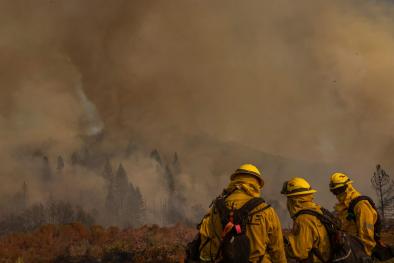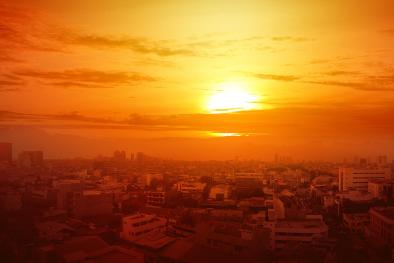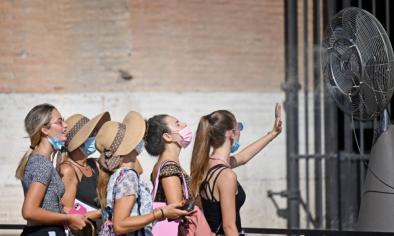Southwest US Heat Wave June 2021
Record-breaking triple digit heat impacted the southwestern US and persisted for days as the jet stream bulged northward, keeping hot air flowing into the region. Temperatures reached 15-25°F above normal and numerous all-time monthly temperature records are in jeopardy. Recent years have shown an uptick in the number of extreme, record-breaking heat events in the region.
Climate change currently causes rare heat waves to be 3 to 5°F warmer over most of the United States. By 2050, US heat waves could be an additional 3 to 5°F warmer.
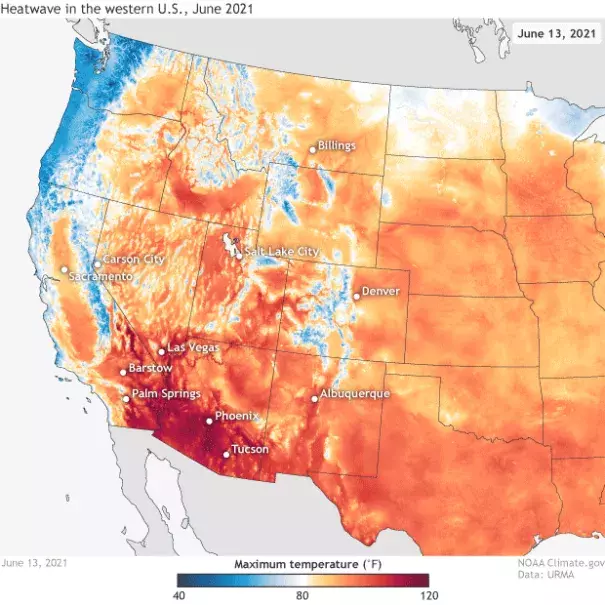
Climate science at a glance
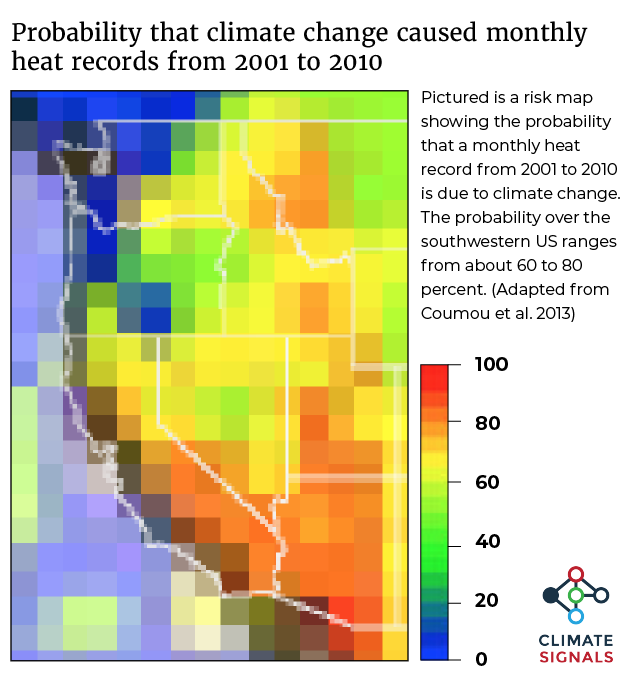
- Heat waves are more frequent across the US since the 1960s, with western regions setting records for numbers of these events in the 2000s.[1]
- Climate change currently causes rare heat waves to be 3 to 5°F warmer over most of the United States. By 2050, US heat waves could be an additional 3 to 5°F warmer.
- Seven of the ten warmest average annual temperature years in NOAA’s Southwest climate region have occurred in the last decade.
- In the Southwestern US, 60 to 80 percent of monthly temperature records during the decade 2001 to 2010 were due to climate change (pictured right).[2]
- For nearly four decades, the average annual temperature in NOAA’s Southwest climate region has increased by 0.6°F per decade relative to the average annual temperature during 1951 to 1980. For context, the global average temperature has increased at a rate of roughly 0.27 to 0.36°F per decade.
- The June 2021 heat wave is just the latest in a series of record-breaking heat events in recent years, before monsoon rains bring some relief to southwestern states. See the following links for recent late spring and early summer heat waves in the region: 2020, 2019, 2018, 2017, and 2016.
Background: high pressure systems
Atmospheric pressure is an indicator of weather. To understand the types of weather conditions generally associated with high and low pressure systems, it helps to think “vertically.”
A high pressure system has higher pressure at its center than the areas around it. When a high pressure system develops in the upper atmosphere, the air below it sinks and compresses because there is more weight on top. This causes temperatures in the lower atmosphere to heat up. High pressure also pushes the jet stream and its drier, cooler air, farther north.
The jet stream is increasingly going off its traditional course and sometimes stalls altogether, and there is a growing body of evidence connecting this change in jet stream behavior to climate change.[3][4] When the jet stream stalls, high pressure ridges get ‘stuck’, leading to longer and more intense heat waves.
Climate signals breakdown
Climate Signal #1: Extreme heat and heat waves
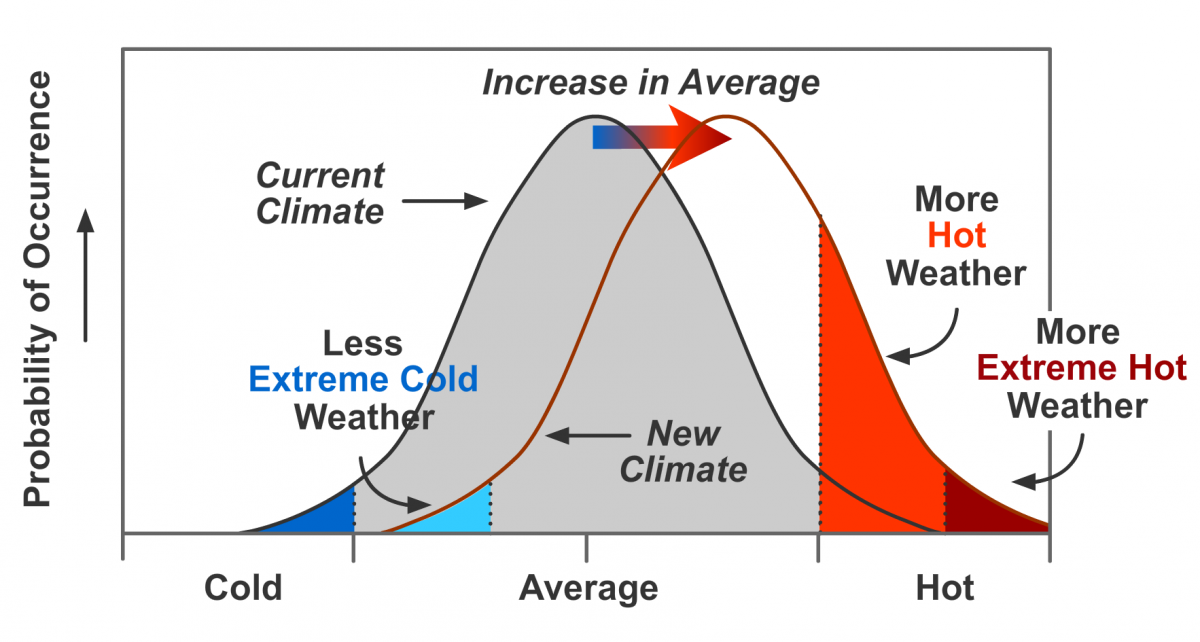 Record breaking temperatures are a classic signal of climate change. As the average global temperature rises and the climate shifts, hot temperatures that were extreme under the old climate are closer to the middle of the new temperature range.[5] Under the earth's climate system, events closer to the midpoint of the climate range occur much more frequently than events closer to the extremes, as shown in the graphic on the right. The shifting bell curve also leads to the occurrence of never-before-seen extremes in high temperatures.[6]
Record breaking temperatures are a classic signal of climate change. As the average global temperature rises and the climate shifts, hot temperatures that were extreme under the old climate are closer to the middle of the new temperature range.[5] Under the earth's climate system, events closer to the midpoint of the climate range occur much more frequently than events closer to the extremes, as shown in the graphic on the right. The shifting bell curve also leads to the occurrence of never-before-seen extremes in high temperatures.[6]
Observations consistent with climate signal #1
-
Salt Lake City, Utah broke a daily record high and tied an all-time high temperature on June 16 (107°F).
-
Phoenix, AZ had the longest streak of 115°F+ heat on record with 6 consecutive days of 115°F+ high temperatures (June 15-20), including a high of 118°F on June 17th. Records in Phoenix go back to August 1865.
-
Palm Springs tied its all-time record of 123°F.
-
Tucson, Arizona, set daily record highs on June 12 (110°F) and June 13 (112°F). Salt Lake City broke a daily record high on June 13 by hitting 102°F.
Climate Signal #2: Atmospheric blocking increase
The widespread and intense heat wave is due to a stagnant high pressure weather pattern that has created a vast area of sweltering heat sometimes referred to as a "heat dome." Intense heat domes used to be rare but have increased dramatically in recent years, a trend that may be linked to human-caused climate change. An analysis of data since 1958 shows that almost all high-powered heat domes have occurred since 1983 — with the overwhelming majority of them occurring since 1990.
Heat domes are often the result of blocks in the jet stream when the west-to-east movement of weather slows or stops. Atmospheric blocking causes weather conditions to persist for long periods and is often behind weather extremes in the mid-latitudes.[7] Research indicates that rising temperatures may increase the frequency of atmospheric blocking events.[3] One analysis identifies an increase in the intensity of persistent high pressure areas over the entire Northern Hemisphere during the summer months from 1979 to 2010.[6]
Observations consistent with climate signal #2
-
The heat wave is due to a "record-strength mid-June high pressure system over the Four Corners region of the Southwest." The high pressure system, sometimes referred to as a heat dome, has brought clear skies, sinking air and an absence of weather systems to the region. It has also diverted the jet stream north, deflecting storms and disturbances and allowing sunshine to pour down from above and heat up the surface.
Climate signal #3: Heat Stress Increase
Exposure to extreme heat is already a significant public health problem and the primary cause of weather-related mortality in the US.[5] As temperatures rise due to global warming, people's exposure to extreme heat conditions increases.[6] The dramatic increase in nighttime temperatures in the US is particularly concerning, because cooler nighttime temperatures provide an important window of relief during heat waves.[2]
Observations consistent with climate signal #3
- Heat advisories were in place for California, Nevada, Arizona and Utah.
- A backpacker who was hiking through the Grand Canyon died from what park rangers believe to be heat-related causes as the high temperature where she was walking hit 115°F. Rangers had to rescue several people over the weekend of June 19-20 due to extreme heat.
Related Content
